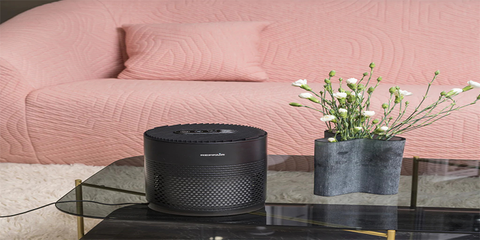PHOTOCATALYTIC PURIFICATION TECHNOLOGY - THE FUTURE OF AIR PURIFICATION

Bad air quality: suffocating truth
According to the Hindustan Times, Delhi has had a lot of trouble with its air quality over the past few years. With an Air Quality Index (AQI) that dipped down to 500+ in several parts of the city, the air in Delhi is considered to be unbreathable for many.

To better understand AQI, anything more than 200 is considered harmful to humans. Unfortunately, the city has had several warnings about its “severe” Air Quality but no solution has been found. According to a news report from abc.net, some pulmonologists have mentioned that breathing Delhi’s air is as harmful as smoking 10 cigarettes every day.

Several people have tried to counter this effect by raising awareness, planting trees, protesting and even making the switch to Electric Vehicles. Although all these actions could possibly reduce the rate of pollution in the long run, it doesn’t really solve the current proble.
What really has worked in the recent past are air purification systems. An air purifier draws air into a filter and pushes out clean air. These filters are designed to filter out minute particles and unpleasant odors as well. If you have symptoms like itchy or watery eyes, runny nose, fatigue or/ and asthma, an air purifier could be one of the best investments in your health.
One of the most rising trends in air filtration and purifying systems is Photocatalytic purification. Yes, it takes your breath away while reading it but is an effective process. Through this blog, we’ll be finding out more about Photocatalytic purification and how photocatalytic activity helps in purifying the air in your personal space.
Photocatalytic Purification Process - An insight:
The process of air purification is considered to be similar to the Earth’s self-cleansing mechanism; a technology that is similar to nature’s photochemical process. Photocatalytic Activity is theorized to be an ideal solution for air purification as it can degrade various types of air pollutants into non-toxic or less harmful particles using solar or artificial Ultraviolet (UV) llight.
But in a line, what is photocatalytic activity? Quite simple actually! Photocatalysis is a green process that changes photonic energy to chemical energy. It is a chemical reaction of light on a catalyst which is a substance altering the reaction rate in its presence, here the Titanium Dioxide. In this process, oxygen radicals are formed which safely destroy organic particles without leaving any residue.
With the aid of a catalyst , in this example titanium dioxide, ultraviolet light serves as the main component of a photocatalytic filter, which purifies the air of contaminants.The contaminants are not captured by photocatalytic filters in their original state. They totally change the poisonous substances by converting the damaging organic pollutants into carbon dioxide and water.
The ultraviolet radiation is not visible to the human eye and has a higher power density than regular light. It has the capacity to generate the precise amount of energy needed to activate the molecules of titanium dioxide and allow the release of electrons to initiate the oxidation-reduction process.

Credible legacy: Photocatalytic Purification
Interestingly, this technology was first used by NASA in the 1970s. The range of applications of this air filtration process is used in space, aviation, automobile and even domestic settings; the applications of photocatalysis are limitless.
Seeking safe and fool-proof filtration systems, the Government of India also introduced Photocatalytic Purification on Vande Bharat trains based on the recommendation of the Central Scientific Instruments Organisation (CSIO), India to provide clean air for passengers traveling by Indian railways.
Other scientific organizations such as the renowned German Fraunhofer Institute for Surface Engineering and Thin Films IST in Braunschweig have been testing numerous ways in which roofs, roads and windows can clean themselves using this very same technology.
Photocatalytic Purification - A need of the hour:
As mentioned, Photocatalytic Purification is very effective and a lot safer than other kinds of filtration technologies. It is eco-friendly and safe for people, pets, animals and the planet. According to various lab test results, tiny microscopic molecules such as viruses, bacteria and moulds were reduced significantly; 99% to be exact. This is an astounding number compared to various other filtration technologies that are present.
Reffair’s LivAir and QX50 are two renowned products that have adopted photocatalytic purification technology. Using this technology, Reffair has closed the gaps on various loopholes that conventional air purifiers use.These air purifiers are considered to be some of the most effective air purifiers in the market with high-grade TRUE HEPA filters as well.
The LivAir Air home and office air purifier uses a Photocatalytic + UV filtration multi-stage 3-in-1 air filter, active carbon filter and HEPA filter to make sure that even the smallest particles are captured in your environment.
The QX50 is a high-performance car air purifier with advanced dust and PM 2.5 sensors that can automatically detect the air quality & adjust the fan speed. It is also powered by a 6-stage effective photocatalytic filtration.
This is how Reffair brings to you the answer to clean air with its best-in-class photocatalytic air purifiers.



